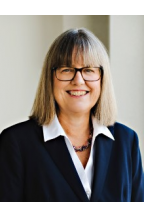Donna Strickland

Biography
Donna Strickland is a professor in the Department of Physics and Astronomy at the University of Waterloo and is one of the recipients of the Nobel Prize in Physics 2018 for developing chirped pulse amplification with Gérard Mourou, her PhD supervisor at the time. They published this Nobel-winning research in 1985 when Strickland was a PhD student at the University of Rochester in New York state. Together they paved the way toward the most intense laser pulses ever created. The research has several applications today in industry and medicine — including the cutting of a patient’s cornea in laser eye surgery, and the machining of small glass parts for use in cell phones.
Strickland was a research associate at the National Research Council Canada, a physicist at Lawrence Livermore National Laboratory and a member of technical staff at Princeton University. In 1997, she joined the University of Waterloo, where her ultrafast laser group develops high-intensity laser systems for nonlinear optics investigations. She is a recipient of a Sloan Research Fellowship, a Premier’s Research Excellence Award and a Cottrell Scholar Award. She served as the president of the Optical Society (OSA) in 2013 and is a fellow of OSA, the Royal Society of Canada, and SPIE (International Society for Optics and Photonics). Strickland is an honorary fellow of the Canadian Academy of Engineering as well as the Institute of Physics. She received the Golden Plate Award from the Academy of Achievement and holds numerous honorary doctorates.
Strickland earned a PhD in optics from the University of Rochester and a B.Eng. from McMaster University.
Research Interests
Intense laser-matter interactions
Nonlinear optics
Short-pulse, intense laser systems
Photonics
Optical Systems
Scholarly Research
Education
1989 PhD Optics, University of Rochester, Rochester, NY
1981 B.Eng Engineering Physics, McMaster University, Hamilton, Ontario
Awards
2018 Nobel Prize in Physics “for groundbreaking inventions in the field of laser physics” for the "method of generating high-intensity, ultra-short optical pulses.”
2008 Fellow of the Optical Society of America
2000 Cottrell Scholars Award from Research Corporation
1999 Premier’s Research Excellence Award
1998 Alfred P. Sloan Research Fellowship
Service
2004-2010 topical editor, Optics Letters
Professional Associations
2014 OSA Board of Directors
2013 President, OSA
2011 Vice-President, OSA
2008-2011 OSA-appointed representative to the International Commission for Optics (ICO) Board
2005-2007 Director at Large, OSA Board of Directors
Teaching*
- PHYS 394 - Light-Matter Interactions
- Taught in 2025
- PHYS 714 - Nonlinear Optics
- Taught in 2020, 2022, 2024
* Only courses taught in the past 5 years are displayed.
Selected/Recent Publications
"Compression of amplified chirped optical pulses", Donna Strickland and Gerard Mourou, Optics Communications 55(6) 447-449 (1985)
"A tunable mid-infrared source (16-20 μm) from an ultrafast two-color", M. Hajialamdari, D. Strickland, Opt. Lett. 37,3570-3572, (2012)
"Two-color fiber amplifier for short-pulse mid-infrared Generation", R. Romero-Alvarez, R. Pettus, Z. Wu and D. Strickland Opt. Lett. 33, 1065-1067 (2008)
"Anti-Stokes Enhancement of Multi-Frequency Raman Generation in a Dispersion-Matched Hollow Fibre" F.C. Turner and D. Strickland Opt. Lett. 33, 405-407 (2008)
"Multi-frequency parametric IR Raman generation in KGd(WO4)2 crystal with biharmonic ultrashort pulse pumping" L. L. Losev, J. Song, J. F. Xia, Z. and D. Strickland, V. V. Brukhanov, Opt. Lett. 27, 2100-2102 (2002)
"Development of a dual-wavelength Ti:sapphire multi-pass amplifier and its application to intense mid-infrared generation" J. F. Xia , J. Song, and D. Strickland, Opt. Commun. 206, 149-157 (2002)
"Dual wavelength chirped pulse amplification system" Z. Zhang, A. M. Deslauriers and D. Strickland, Opt. Lett. 25, 581 (2000)
In The News
- Canada’s newest Nobel Prize winner, Donna Strickland, ‘just wanted to do something fun’, The Globe and Mail
- Nobel laureate Donna Strickland: ‘I see myself as a scientist, not a woman in science’, The Guardian
- For Just the Third Time in 117 Years, a Woman Wins the Nobel Prize in Physics, New York Times
- Donna Strickland, Canada's latest Nobel winner, is a 'laser jock' who loves the lab, Quirks & Quarks
- Physicist Donna Strickland on Her 'Surreal' Nobel Prize Win and the Challenges for Women in Science, Time
- Waterloo professor wins Nobel Prize in Physics
- Words of recognition
- Nobel Prize-winning physics professor follows her gut
- Nobel Prize-winning physicist helped make lasers ubiquitous
- Women of the Nobel Prize for Physics